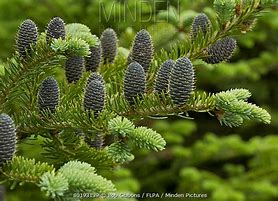Balsam Canadian - Abies balsamea






Balsam Canadian - Abies balsamea
Family: Apinaceae
SYNONYMS: A. balsamifera, Pinus balsamea, balsam fir, balsam tree, American silver fir, balm of Gilead fir, Canada turpentine (oil).
General Description:
A tall, graceful evergreen tree up to 20 metres high, with a tapering trunk and numerous branches, giving the tree an overall shape of a perfect cone. It forms blisters of oleoresin (the so-called 'balsam' on the trunk and branches, produced from special vesicles beneath the bark. The tree does not produce a 'true' balsam, since it does not contain benzonic or cinnamic acid in its esters; it is really an oleoresin, being a mixture of resin and essential oil.
Distribution
Native to North America, particularly Quebec, Nova Scotia and Maine.
Other Species
The hemlock spruce (Tsuga canadensis) also yields an exudation sold under the name of 'Canada balsam'.There are also many other species of fir which produce oils from their needles - NB: Not to be confused with the genuine balm of Gilead (commiphora opabalsamum), of ancient repute.
Herbal/Folk Tradition
The oleoresin is used extensively by the American Indians for ritual purposes and as a external treatment for burns, sores, cuts and to relieve heart and chest pains. It is also ued internally for coughs.
Actions
Antiseptic (genito-urinary, pulmonary), antitussive, astringent, cicatrisant, diuretic, expectorant, purgative, regulatory, sedative (nerve), tonic, vulnerary.
Extraction
1. The oleoresin is collected by puncturing vesicles in the bark.2.An essential oil is produced by steam distillation from the oleoresin, known as Canada balsam or Canada Turpentine. (An essential oil is also produced by steam distillation from the leaf or needles, known as fir needle oil.)
Characteristic
1. The oleoresin is a thick pale yellow or green honeylike mass which dries to crystal clear varnish, with a fresh sweet balsamic, almost fruity odour. 2. A colourless mobile liquid with a sweet, soft balsamic, pinelike scent. It blends well with pine, cedarwood, cypress, and other balsams.
Principal Constituents
Consists almost entirely of monoterpenes, pinene, phellandrene, esters and alcohols.
Safety Data
Generally non-toxic, non-irritant, non-sensitizing. 'In large doses it is a purgative and may cause nausea.
Aromatherapy/Home Use
Skin care: Burns, cuts, Haemorrhoids, wounds.
Respiratory System: Asthma, Bronchitis, Catarrh, chronic coughs, sore throat.
Genito-urinary system: Cystitis, genito-urinary infections.
Nervous System: Depression, nervous tension, stress-related conditions - described as 'appeasing', sedative, elevating, grounding, opening'.
Other Uses
The oil from the oleoresin is used in certain ointments and creams as an antiseptic and treatment for haemorrhoids. Used in dentistry as an ingredient in root and canal sealers.
Also used as a fixative or fragrance component in soaps, detergents, cosmetics and perfumes.
There is some low-level use in food products, alcoholic and soft drinks. The oleoresin is used as a medium in microscopy and as a cement in glassware.
Reference: The Encyclopedia of Essential Oils: Julia Lawless
Articles Latest
- Chamomile Roman - Chamaemelum nobile
- Chamomile Maroc - Ormenis multicaulis
- Chamomile German - Matricaria recutica
- From Biology To Aromatherapy
- Plant Messengers
- Celery Seed-Apium graveolens
- Cedarwood Virginian - Juniperus virginiana
- Cedarwood, Texas- Juniperus ashei - Essential oils
- Cedarwood Atlas- Cedrus atlantica - Essential Oils
- Cassie - Acacia Farnesiana - sweet acacia
- Cassia - Cinnamomum Cassia
- Cascarilla Bark - Croton eluteria
- Carrot Seed- Dacus Carota
- CARDAMON
- CARAWAY
- CANANGA
- CAMPHOR
- CALAMUS
- Calamintha-Calamintha officinalis
- CAJEPUT- Melaleuca cajeputi
- Plant Expression
Articles-Most Read
- Home
- Balsam Canadian - Abies balsamea
- Balsam Peru
- Copaiba Essential Oil
- North America: Tea Tree and Monarda-3
- Basil French - Ocimum basilicum
- Basil Exotic
- North America: Tea Tree and Monarda-2
- Exploring Transcultural Constants
- Thyme Essential Oil
- Balsam Tolu
- Palma Rosa
- Bay - West Indian - Pimenta racemosa
- The Bioactivity of Essential Oils
- Benzoin - Styrax benzoin
- Why Pharmacology Cannot Demonstrate Essential Oil Efficacy
- Exploring Essential Oil Activity The Conventional Way
- Complex information From Plants
- Aromatherapy: An Answer
- Contacts
